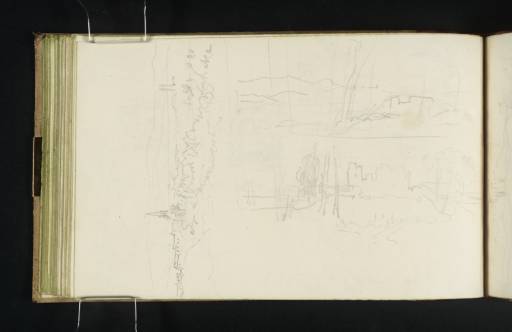Joseph Mallord William Turner Lochmaben Castle, Near Lockerbie 1831
Joseph Mallord William Turner,
Lochmaben Castle, Near Lockerbie
1831
Joseph Mallord William Turner 1775–1851
Folio 57 Verso:
Lochmaben Castle, Near Lockerbie 1831
D25874
Turner Bequest CCLXVI 57a
Turner Bequest CCLXVI 57a
Pencil on white wove paper, 114 x 187 mm
Inscribed in pencil by Turner ‘Loch aben’ top left running vertically
Inscribed in pencil by Turner ‘Loch aben’ top left running vertically
Accepted by the nation as part of the Turner Bequest 1856
References
1909
A.J. Finberg, A Complete Inventory of the Drawings of the Turner Bequest, London 1909, vol.II, p.856, as CCLXVI 57a, as ‘Three views; a town, ruins, &c.’.
Lochmaben Castle was on Turner’s list of subjects to sketch in preparation for illustrations to a new edition of Scott’s Poetical Works,1 and it became the vignette illustration to volume 3: Lochmaben Castle circa 1832 (whereabouts unknown).2 Turner reached the town of Lochmaben by the main road between Dumfries and Lockerbie after having stopped to make sketches at Torthorwald Castle (folio 57; D25873). Gerald Finley identified the sketches on folio 59 and nearby (these are folios 57 verso–60 verso; D25874–D25880), and observed how despite viewing the castle through an obscuring ring of trees, Turner (having studied the ruins up close and from different angles) was able mentally to see ‘the ruins without the full and immediate experience of them.’3 The sketches of the castle on the present page therefore include trees in the foreground, but many of those in the top right sketch are made transparent by being only faintly suggested by vertical lines.
From the order of sketches in this book it appears that Turner started sketching the castle, which sits on a promontory at the southern end of Castle Loch, from the south when he reached it from the path from the town (folios 57 verso–58; D25874–D25875). He then followed the path anticlockwise around the loch (folios 58–59; D25875–D25877) until it joined the road to Lockerbie at the east end (folio 59). He then returned to the castle to sketch it at close quarters (folios 59 verso–60; D25878–D25879), before retracing his steps to reach the road to Lockerbie, from where he made two final sketches as he headed to his next destination (folio 60 verso; D25880).
Turner’s study of the castle was indeed methodical and over about two dozen sketches he recorded it from far and near and from most directions.
On the present page there are three sketches, two of which are of the castle. The other view, made at the left of the page and with the sketchbook turned to the right, is of the town of Lochmaben and is faintly inscribed ‘Loch [m]aben’ at the bottom right of the drawing. From the south or west, over bushes and shrubs and with a line at the bottom left that suggests the water’s edge (perhaps of Kirk Loch), are two towers which stand at either end of the High Street: the 1723 Town Hall (which still exists although the rest of the building was rebuilt in 1877) at the left, and the Parish Church to its right. There may be another view of the Town Hall at the very bottom of folio 58.
The two views of Lochmaben Castle were made from the south of Castle Loch, which can be seen most clearly in the top sketch. There is another view of the loch from the south at the top of folio 58.
Thomas Ardill
September 2009
Andrew Wilton, J.M.W. Turner: His Life and Work, Fribourg 1979, pp.427–8 no.1075. The watercolour design for the vignette is currently untraced, although an alternative design (Wilton 1979, p.436 no.1150) was sold at Sotherby’s in London on 10 December 2008. This other design is not a vignette but has a similar horizontal ‘landscape’ composition and similar dimensions to the frontispiece designs of the Poetical Works.However, there is no reason for Turner to have made a frontispiece version of the subject as Lochmaben was established as the vignette from the 6 August list, drawn up while Turner was staying with Scott at Abbotsford. It was then confirmed as a vignette on 17 September, although rather than appearing in volume 2 as originally designated it ended up in volume 3 (Finley 1980, pp.240–1). Unless there was a temporary unrecorded decision to make the subject a frontispiece, this work must have been made for another purpose. One possibility is suggested by Andrew Wilton, who claims that the work (which he mis-identified as Kilchurn Castle and Loch Awe), was ‘possibly intended for use in Fisher’s Illustrations to the Waverly Novels’ (Wilton 1979, p.436 no.1150).
How to cite
Thomas Ardill, ‘Lochmaben Castle, Near Lockerbie 1831 by Joseph Mallord William Turner’, catalogue entry, September 2009, in David Blayney Brown (ed.), J.M.W. Turner: Sketchbooks, Drawings and Watercolours, Tate Research Publication, December 2012, https://www

